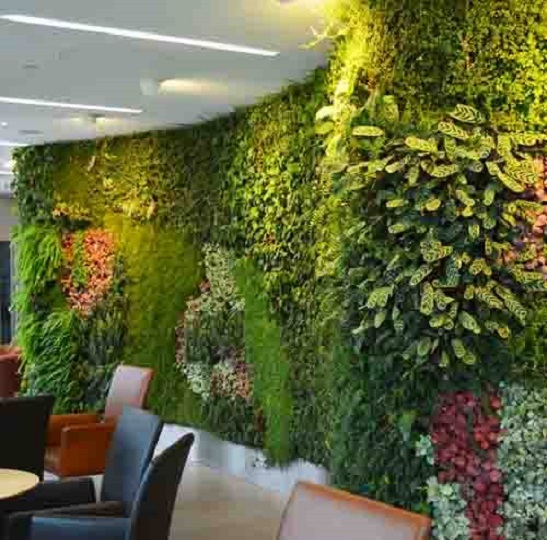Natural Light – Importance in the Workplace
A recent survey by Future Workplace concludes that natural light makes a considerable difference to employee wellbeing. The opinion of many that participated in...
Read Full Article
Can interior plants create a healthy, thriving office in the post-COVID era?
As restrictions lift, many businesses are starting to consider welcoming staff back into the office once more. For some workers, being in the office environment increases productivity and enables them to focus on their daily tasks without being disturbed by deliveries or having to juggle childcare.
These workers, as Matt Monckton, Regional Manager from Nurture Landscapes explains, need to be in an environment where health and wellbeing are prioritised, and plant displays can be a significant building block in creating the perfect office for a post-pandemic world.
Matt Monckton has been working within the commercial horticulture sector since 1989. One of his proudest moments was winning a RHS Chelsea Flower Show Silver Gilt medal in 2016 for a Fibonacci themed garden. He started his career within horticulture as a plant maintenance technician in 1992, and has worked his way up through Nurture Landscapes by supervising the interior plant maintenance department, and working within the sales team. Monckton is now Regional Manager for the Plant Displays division.
There’s no mistaking that the world is a different place as a result of the COVID-19 pandemic, especially when it comes to the way we work on a daily basis. Now that offices are cautiously beginning to reopen, it’s important to consider what employees need and expect from a post-pandemic working environment.
The positive effects of workplace design on teams have been documented for a number of years. What is perhaps different now is that the various lockdowns have made people appreciate nature more and the health benefits that plants can bring.
In fact, a report published in the Financial Times in September 2020 suggested that gardening was the second most-popular lockdown activity, ahead of exercising and reading, and a second article in the Guardian reported of surging sales of house plants as people strived to find a way of easing their anxieties about what was happening in the world.
To a degree, this is what makes office interior plants so important. Simply being around plants, which release oxygen, has been shown to lift mood and reduce fatigue by as much as 25 per cent, whilst also improving the air quality in a room by removing dust and bacteria.

Picture: a photograph of one of Nurture Landscapes' living wall installations
More than anything, interior office plants enable workers to have a connection to nature, which may have been lacking with the amount of time they have had to spend indoors due to the nationwide lockdowns. Green, or living, walls are particularly effective at bringing a small piece of the natural world into the workplace environment, improving the visual aesthetic of the office and improving the overall wellbeing of staff in the process.
Living walls have been particularly beneficial to headquarters in urban areas, where it is next to impossible to take time out of the day to sit in a park on a bright day. Being in heavily urbanised or populated areas may also cause worries about being unable to maintain physical distancing and make workers more likely to want to remain inside during their lunch break. Providing refuge away from the daily grind without having to confront crowds eases these anxieties and will make the transition back into office working smoother.
Inevitably, this transition will affect each staff member differently. Some may find it an easy return, whilst others will need more support. According to Bupa, more than a quarter of employees are fearful of the better work-life balance many have had as a result of working from home. However the adverse effect of this is burnout and fatigue, as a result of losing the separation between the two worlds.
Physical distancing measures will need to remain in place, at least for the short-term, however, using plant displays to partition desks ensures teams are suitably spaced apart yet still connected in an uplifting, vibrant setting.

Picture: a photograph of Matt Monckton
COVID-19 has, without question, affected how businesses use their available space. Flexible office space is becoming more of an expectation from employees, with nearly half of UK businesses planning to include greater use of coworking space. Similarly, 63 per cent expect a greater focus to be on their office designs post-COVID-19.
The right combination of office plants and open space which paves the way for agile collaboration and flexibility will be integral to adapting the workplaces of the post-pandemic world. Though remote working has its benefits, such as removing stressful commutes and not having to spend hard-earned wages on transport or fuel, 80 per cent of employees missed the daily, face-to-face interaction with colleagues.
As we at Nurture Landscapes have frequently noticed with our clients, plant displays are becoming more of an important factor in how businesses want to portray themselves to staff and customers. Demonstrating a focus on being green, sustainable, and an organisation which cares about staff wellbeing enhances reputation and staff morale, and workers who may be feeling apprehensive about a return to a physical office may feel more assured that their company is taking steps to support them.
Of course, office plants are no substitute for the COVID-19 safety measures we have been accustomed to, but they do, at least, make the workplaces of the new world areas where people can once again connect with each other, and a place that they feel proud to return to.
Picture: a photograph of a person facing a large window in an office, sitting in a chair, with a plant close by
Article written by Matt Monckton | Published 30 April 2021
A recent survey by Future Workplace concludes that natural light makes a considerable difference to employee wellbeing. The opinion of many that participated in...
Read Full ArticleTake a look inside Soho Estates' new headquarters, located on the top floor of new-build Ilona Rose House. The 7,500 sq ft space is the property company's...
Read Full ArticlePantone’s Colour of The Year has been revealed as the crimson red tone "Viva Magenta" and is predicted to dominate interiors, graphic design and packaging...
Read Full ArticleThis month’s high performing buildings roundup looks at the enduring workplace trend of biophilic offices. Biophilia is the human drive to connect with nature...
Read Full ArticleReena Mistry, Head of Marketing at Flogas, explains the benefits of six plants that are ideal in office space for their low maintenance and air quality...
Read Full ArticleLondon’s art students could see their work showcased publicly and win a series of prizes as part of a competition from Landmark Space and Art in Offices. Artists...
Read Full ArticleOrdinary potted house plants can potentially make a significant contribution to reducing air pollution in homes and offices, according to new research led by the...
Read Full ArticleIn 2019, two eight-story towers became the new office of JetBrains in Saint Petersburg, Russia. It is now a best-in-class example of a "green...
Read Full ArticleThisWeekinFM attended Clerkenwell Design Week, which was held from 6 to 8 July 2021 and showcased a range of innovative workplace interiors. Clerkenwell is an area in...
Read Full ArticleFit-out firm Overbury is to deliver a new flexible workplace across 12,000 sq. ft. of office space at the landmark Paradise Birmingham development. The new space is...
Read Full Article